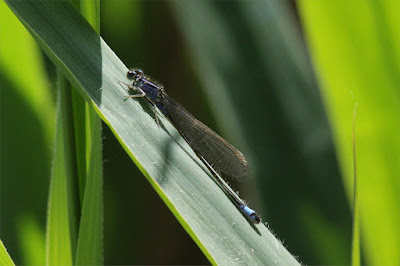 |
| Black tern and herring gull |
After a good night's sleep I should have been ready for a full day's birdwatching but spent the morning dithering about and achieving not very much. So it was lunchtime before I set out for Pennington Flash. And mid-afternoon by the time I finally arrived after the 126 was diverted from the motorway and had to go through Barton and the length of Worsley Road then hit roadworks in Boothstown.
 |
| A particularly fidgety coal tit |
Walking in from St Helens Road the hedgerows were busy with birds. Robins, blackbirds and wrens sang, woodpigeons cooed and magpies chattered and shrieked. A coal tit was too busy collecting food to be bothered with people and I spent a minute getting lots of photos of where it was a moment ago and struggling with a very close focus on the big lens. A family of great tits were impossible to photograph as much because they made sure they kept a leaf between themselves and the lens as their manic bouncing around in the hawthorns.
 |
| Elder blossom |
There wasn't a single bird on the brook. It was running at half speed and didn't have any of the usual shoals of minnows either.
 |
| Mistle thrush |
A mistle thrush fed on the lawn before the car park. It wasn't bothered by passersby until it noticed I'd stopped to watch it as it pounced on beetles and spiders and was trying to get a photo. Instead of the usual rattling flight it crouched into the grass until I put the camera down. It carried on as before and I left it to it.
 |
| Mute swan |
The car park was busy with people and Canada geese. A few mallards and a couple of mute swans joined them in begging for bread. A few more mallards and a Muscovy duck dozed on the bank of the flash. There weren't many gulls about though the black-headed gulls tried to make up by noise what they lacked in numbers. A dozen or so each of herring gulls and lesser black-backs loafed on the water over by the sailing club, reluctantly moving out of the way whenever a yacht sailed by.
 |
| Black tern |
There didn't look to be any swifts or hirundines hawking over the water, probably disturbed by the boats. Three distant dark shapes caught my eye as they swooped around taking not a bit of notice of them. Too big to be swifts, they soon came close enough in mid-water for me to be sure they were black terns. They didn't get any closer and I struggled to get any record shots. This must have been the start of a passage, I reported these at half three, there was a report of six three hours later and eleven were reported at dusk. The accident of being in the right place at the right time is a feature of birdwatching that still delights and frustrates.
I didn't get any better a view of the terns from the Horrocks Hide though I did spot a few swifts and sand martins feeding very high above the flash. Mallards, lapwings and coots loafed and fidgeted on the spit, black-headed gulls squabbled on the rafts in the bight and a few great crested grebes cruised about. A couple of gadwall were starting their post-breeding moult and will probably be disappearing soon to join the annual flock of hundreds on Woolston Eyes.
 |
| The path from the Horrocks Hide |
A couple of blackcaps and chiffchaffs sang in the trees on the way to the Tom Edmondson Hide. A Cetti's warbler sang by the reedy pool next to the Horrocks Hide while the usual individual sang from the pool opposite Tom Edmondson's with a reed warbler and a reed bunting.
 |
| From the Tom Edmondson Hide |
The couple of herons on the pool at Tom Edmondson's were hidden by the reeds when they weren't squabbling with each other. Pairs of gadwall and mallard drifted about while coot chicks kept their parents busy. I kept hoping for a kingfisher to turn up but it didn't happen. "I've not seen a jay on this pool for a while," I thought to myself and lo, one flew in and rummaged in the trees by the side. I concentrated very hard on a mental picture of a blue-cheeked bee-eater but I'd had my wish for the day.
 |
| Lapwing chick |
The pool at Ramsdales was very quiet save the distant calls of black-headed gulls and a couple of common terns that flew onto the flash. A couple of pairs of lapwings fed as they kept an eye on their tiny youngsters running about on the mud.
 |
| Lapwing parent |
I could — and should — have carried on having a wander but my eyes were feeling the strain of all that glare and I keep having to remind myself this is a pastime not a job. I dawdled back to the bus stop, had fifty-five minutes to wait for a 126 so waited for the 34 and got back to the Trafford Centre via a change of bus in Eccles. Actually seeing rather than only hearing so many of the small birds in the hedgerows had surprised me as much as the arrival of the black terns.
 |
| Bradshaw Leach Meadow |













































